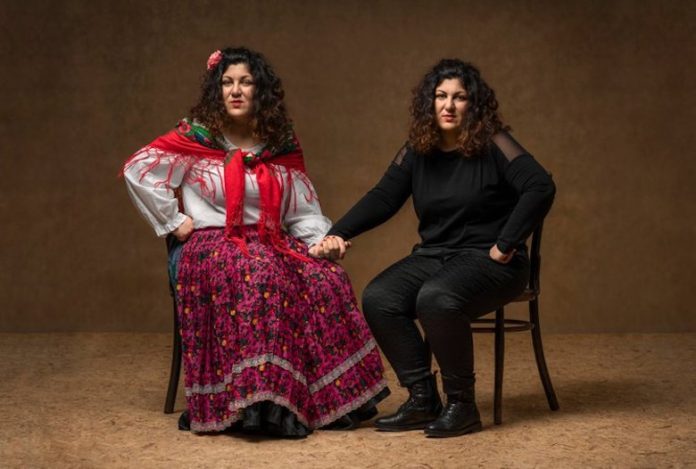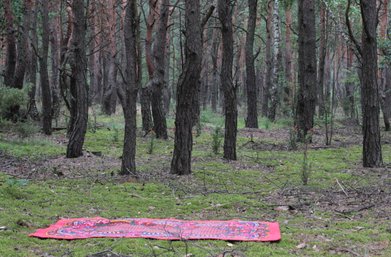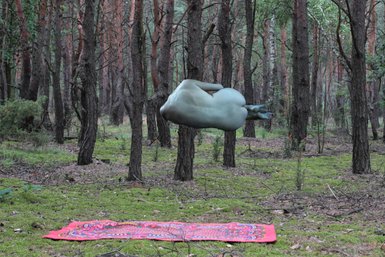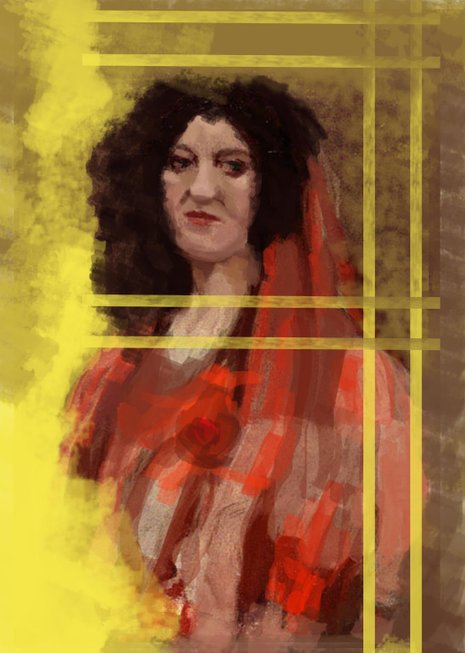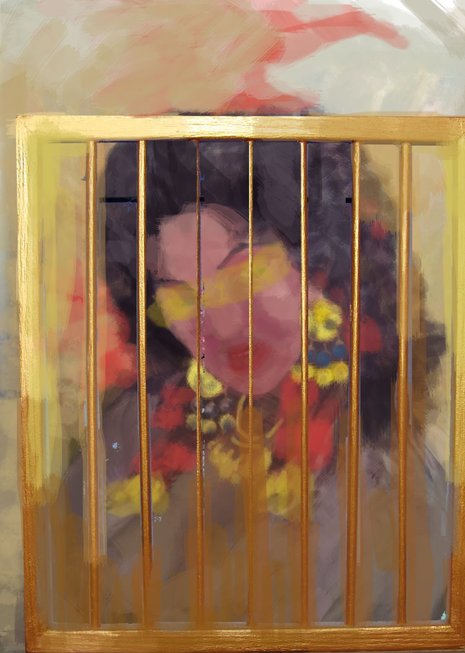The role of contemporary Romani art has an important impact on the Romani culture. Through a blend of the traditional and the futuristic, it re-examines interpretations of historical events and changes the ways in which Romani culture is shaped and understood. Roma artists thus strive for the freedom to articulate their own worldviews, and female Roma artists stand out in particular, as they re-examine and emphasize the stratification of racial and gender injustice through their works. While reading the literature on contemporary Romani feminism and the art within it, I came across the works of Emília Rigová, an artist who makes use of her alter ego Bári Raklóri to visually express issues that mainly relate to her Romani identity. It is an author’s method that deals with the topic of cultural or social stereotypes, but also of the alter ego, Romani identity, and psychological shadows.
Bári Raklóri is the embodiment of the interconnectedness of Roma and non-Roma and the synergy she attains by drawing both worlds. In her family, this connection and relationship were always perceived as a symbiosis, not as hostility. In the family, the artist was often referred to as Bári, which means big. The second component of the alter ego’s name is a term for a non-Roma girl or a daughter of non-Roma parents, that was often used when parents of Romani children wanted to express satisfaction with the neat appearance and clothing of their children. On such occasions, they would tell their children: You are as beautiful as a raklóri (non-Roma girl/boy).
Specifically, I use ‘the Romani topic’ or ‘the Romani matter’, even I hate these shallow designations, to consistently create a new narrative concerning the representation of the Romani body throughout the history of art. I enjoy challenging the viewer about “their” preconceived image of a Romani person. In fact, all my art projects represent a complex set of critical reflections on how we, as a society, accept a dictate, verbal or visual.
Emília Rigová is a visual artist from Slovakia. In addition to her artwork, she teaches art courses (object, multi-media, inter-media) at Matej Bel University in Banská Bystrica. For Rigová, an object – in the form of an installation, as a performance, or a site-specific intervention is the central element of her artistic expression. Through the contents of her work, Rigová explores emotions modified by a certain socio-cultural environment and considers herself to be her own life project. In her search for authenticity, she relies on personal experience when creating works of art. This same experience is processed, reconstructed, and ultimately recreated, so that the methods resulting from creation become the drivers of her own transformation.
Art is like a myth, neither truthful nor deceitful, its perception and interpretation depend only on our perspective.
Stylization into a stereotypical image allows Rigová to reconstruct it, and she states that this is quite characteristic for the works of authors specifically dealing with the topic of Romani identity.
Yes, we are working with the stereotype, but we are only using it in order to disprove it. That’s the irony – to disprove a stereotype, we need to work with it for a while so that we can pinpoint what exactly needs disproving. However, by doing so, we contribute to the same cycle of false copy-paste images, so it’s a double-edged sword.
In 2018, Rigová presented, among other things, her self-portrait diptych Keres Kultura (Do we create culture?) to the Croatian audience in the Small Salon of the Museum of Modern and Contemporary Art. In it, the central motif is her golden teeth. While the author asks keres kultura, she also contemplates the adoption of stereotypes imposed by the dominant culture that become part of Romani identity and incorporation into their own bodies.
Romani identity is becoming a sort of transnational identity – an opportunity for a person to come to terms with their otherness. The Romani are a perfect example that multiculturality is and always has been present – it is our perspective and acceptance that change. It saddens me how uncritical we are in thinking. It’s all about worldviews.
Without consent and knowledge
Forced sterilization of Romani women is a topic that Rigová has been dealing with for some time, and a project titled Final Cut, which she is still working on, mirrors the historical context of the topic of eugenics from World War II and the communist regime. The second part of the project is personal in nature and it is dedicated to her mother and the way the family coped with the sterilization experience that was part of state policy in Czechoslovakia until 1993 when the Sterilization Directive was repealed. A large number of Romani women have been sterilized without informed consent, under false pretenses, or without them being conscious. According to a 2016 report by the European Roma Rights Center, the practice of sterilizing Romani women and women with disabilities against their will did not end with the repeal of the law that allowed it but continued during the 1990s and 2000s, and the last known case took place in 2007.
Her mother was subjected to sterilization in 1980, following her birth, and she had only found out about it after 1989 during a regular medical examination. However, as Rigová points out, this artistic presentation does not aim at conveying the individual experience of her mother, but all women in various historical, political, and geographical contexts who have been deprived not only of their physical integrity but also of their right to joy and care. Forced sterilizations are thus a striking example of the modern state’s intervention in restricting the reproductive rights of certain groups in society. The title of the project Final Cut is an allusion to the final solution and thereby the communist practice related to the eugenic practice of the Nazi regime.
Exotic fantasy on the margins of society
Through her works, Rigová is particularly interested in minorities who have been systematically eradicated from the hegemonic historical discourses, collective memory, and visions of the common future. For this reason, she draws on the contextual interpretation of the art of Western culture and its canonical representations embedded in their specific historical contexts.
The Roma have influenced European art, which, in turn, through various products of visual culture, became one of the most prominent instruments in the colonization of the largest European minority. Rigová points out that the image of Romani and Gypsy women from the last century was depicted as a cheap sexual trophy, and that the idea of Romani women, conceived by non-Romani men, has misguided entire generations for centuries. In her cycle of works Bári Raklóri, the artist stylizes the romantic myth of the Romani woman, the one from various historical posters, postcards, and paintings. In the video installation titled Constant Metamorphosis (Covering up), she works with portraits of two women, sewing their faces with a rope. The authentic sound of a needle and rope piercing through the canvas amplifies the author’s dramatic and intimate intervention, which thereby critically re-examines the old-fashioned role of women and their position in society.
Therefore, it is less important whether the character of Bizet’s Carmen or Hugo’s Esmeralda is analyzed, the theme of fetishization is very close to this artist, as are the icons, sacred images, and ritual objects with which she was surrounded since childhood. This was common in her family, especially during adolescence, while the generation of her grandparents was still alive, and they were surrounded by photographs of deceased relatives, but also by cheap ordinary pop-culture trinkets. Such artifacts can still be found in the homes of sub-ethnic Romani groups, Rigová continues, who, as traveling nomads, migrated all across Europe, or are visible in films on the Roma, as a reference to what their homes once looked like.
I think it is precisely because they migrated a lot – they carried those portable shelves around. When you look at the records from that period of time, you can see that almost every caravan had a shelf lined with authentic ‘icons’, pictures of close people, or various ritual objects. My authentic world has always been made up of things that somehow make me feel good – things that I like to look at or touch. Seeing the Romani traditions through these objects and mementos of a point in time, together with finding the penetrations of said traditions in the current generation, can tell a much more valuable and comprehensive story about the Roma. An outside observer probably wouldn’t understand it without an introduction.
It is a pity that Romani traditions and customs are still largely misunderstood, Rigová notes, as it cannot be denied that the Roma have migrated for a very long time and lived in a very specific way in the past.
I think that’s what made them different – they had to carry with them what was most important and valuable to them. Over the centuries, they have consistently collected everything their world was made of. And it’s both funny and sad that nobody knows anything about it, it’s not been recorded and nobody has ever described it, yet it’s still a part of Romani lives. It is beautiful.
Pyšná as proud
In terms of the position of Romani women in Slovakia, Rigová states that specific differences could be identified when compared to the position of Romani women some thirty years ago. Yet, she holds that their position is similar to that of non-Roma women today.
There is the same spectrum of feelings and opinions, and I really don’t see any difference. Maybe nowadays, the Romani women have more power over the way the entire Romani community functions. There is an opportunity for someone who understands and has been a part of the topic to explain that women actually hold a high position in the Romani community, even though it may not seem so from the outside.
In the past, there were laws prohibiting Romani women from talking at the same table as men. For example, she states, in Vlach Roma communities this still holds today.
On the surface, it may seem that a woman has no power there, but it is the opposite. A woman holds the community together in a completely different way than a man. I understand that on the outside, the Romani community can seem terribly patriarchal, but at least in my case, the women in my family were and still are very strong characters. My grandmother was even one of the first Romani women in Slovakia to divorce her husband in the 1970s.
And it was her grandmother Teresa who found herself as the inspiration for one of the interpretations that Rigová painted in the Bári Raklóri cycle. Her grandma’s maiden last name was Pyšná, translated as proud, and so Rigová ends our conversation with the message that for Romani women, it is important to realize who they are, what they feel, and what they are capable of, all with the goal of loving themselves, without trying to fit into someone else’s clothes. Instead, Rigová concludes, let’s sew our own!
The publication of this text was supported by the Electronic Media Agency as part of the program to encourage journalistic excellence


